All the OPTIMUM brand of SP-500 market timing models have been moved under a new page and menu item at https://recessionalert.com/pro-optimum/
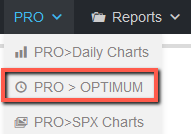
These models span various time horizons and have explicit entry/exit rules used in their back testing that can easily be replicated by subscribers into the future. They are defined as Macro models that work across bull and bear markets and bull-market models that are designed and optimized to perform during bull markets only. One of the requirements of OPTIMUM models is they all have standardized performance tables starting from March 2009 (longer for the macro models) that allows you to compare their respective characteristics and risks. More specifically these include total trades, winners, losers, winning %, losing %, points gained on winners, points lost on losers, net points gained (points gained less points lost), reward/risk ratios (points gained divided by points lost), average winning trade size, average losing trade size and total cumulative returns (TRI). The models are briefly described below, but their respective tabs in the OPTIMUM menu will have further detail of their mechanics, and daily updates to more recent trade depictions on a SP500 chart and detailed performance statistics.
It is important to note that most of these models will struggle to outperform a buy and hold strategy during a bull market. This of course assumes the buy & hold investor has perfect hindsight in calling the ultimate top of the market. Most of these models’ trade returns in favour of lower risk of getting caught in the big bear market. The aim is thus not to beat buy & hold but to have frequent favourable entry points offered into the market with a high confidence of a successful outcome and highly respectable cumulative returns whilst protecting against downside risk. In other words, favourable risk adjusted returns. In most cases these models have far less volatile returns and lower drawdown profiles whilst paying a small price in loss of buy & hold returns.
1. OPTIMUM-1 : A long-term low frequency (7 trades since 2009 and 13 trades since 1982) macro-model that aims to capture & avoid as much of the entire extents of bull and bear markets respectively. These bull and bear markets typically are aligned with the economic cycle. This model has such timely accurate signalling of new bull markets that it earns itself a place as one of the seven models in the MEGA tab in the DASHBOARD. Whilst this model has an exemplary long-term macro record, it will under-perform buy-and-hold and the other models in a bull market. Its long term history is depicted below:
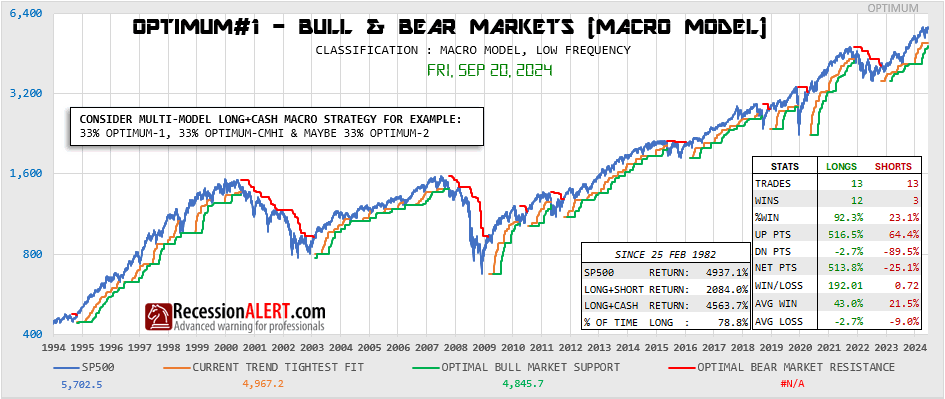
2. OPTIMUM-2 : A low frequency bull market model (10 trades since 2009) optimized for long-trade net winning points gained. Although it has a similar frequency since 2009 to OPTIMUM-1 this model will outperform OPTIMUM-1 in a bull market since it is not stunted with assumptions that need to be made to protect it from bear markets.
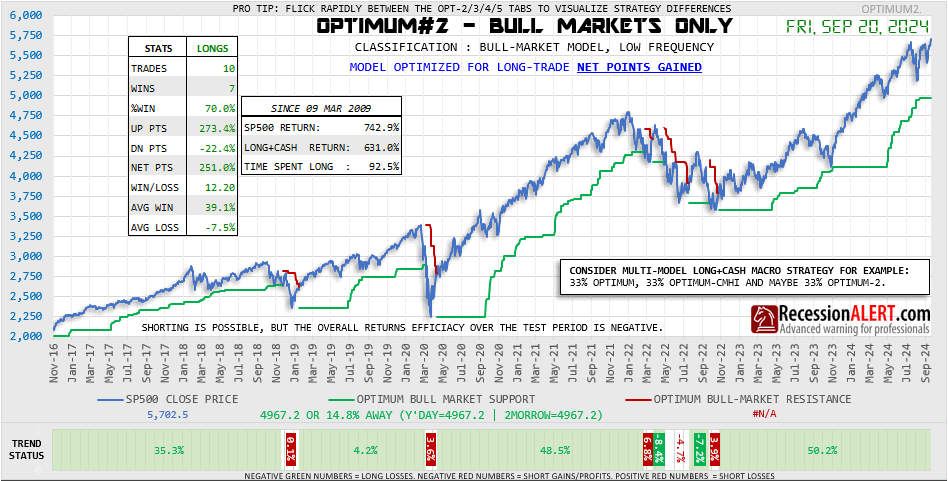
3. OPTIMUM-3 : A low-to-medium frequency bull market model (14 trades since 2009) optimized for long-trade win rate %.
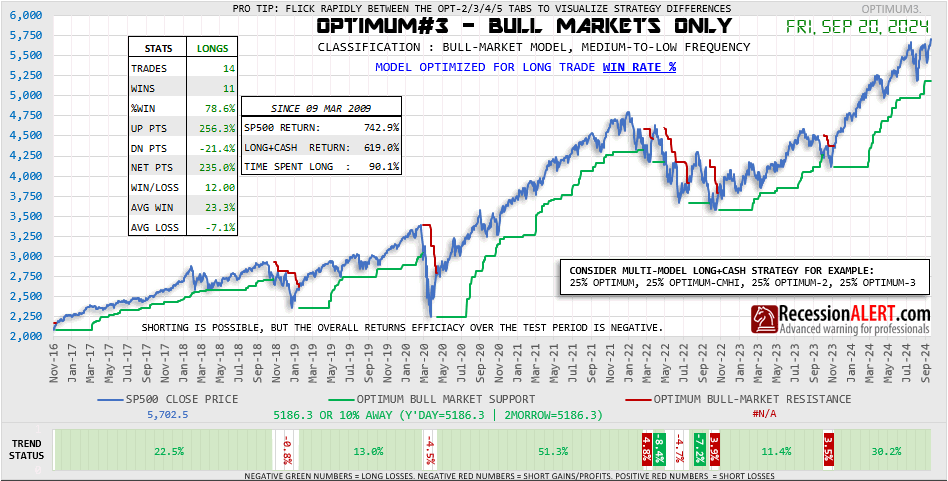
4. OPTIMUM-4 : A medium frequency bull market model (18 trades since 2009) optimized for long trade total accumulated returns (TRI).
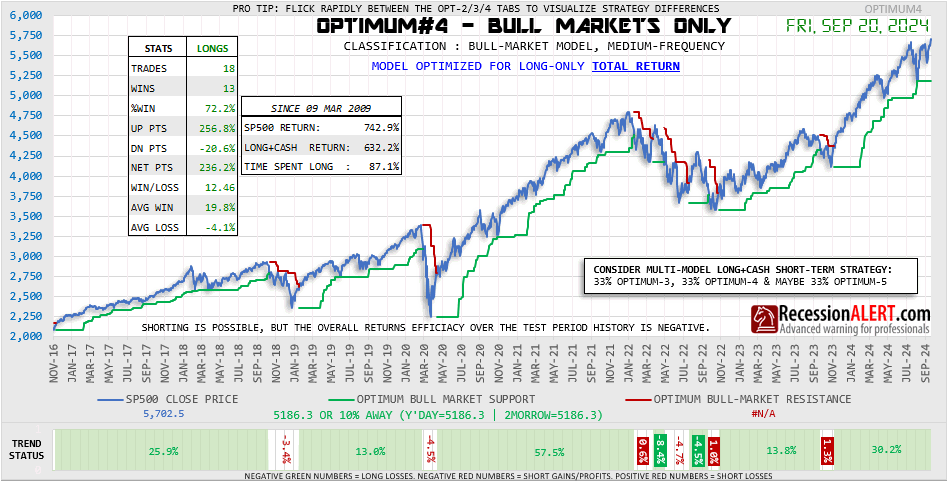
5. OPTIMUM-5 : A high frequency bull market model (31 trades since 2009) optimized for highest trade frequency with acceptable long-trade performance statistics.
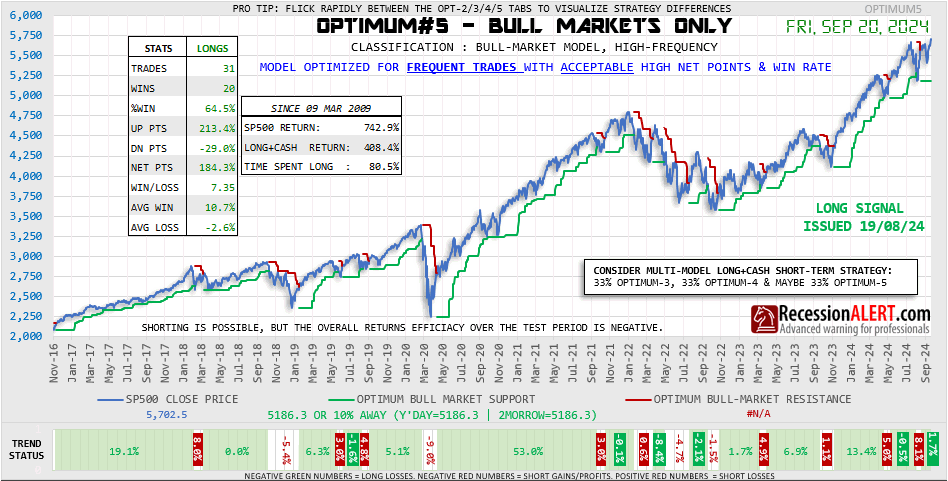
6. OPTIMUM-CMHI : A long-term medium-frequency macro model (21 trades since 2009) built on the back of the CMHI (Composite Market Health Index) engine which has been around for some time now. Whilst its objectives are similar to OPTIMUM-1 it does feature some exceptional intra bull/bear moves to improve alpha which allows it to perform well in bull and bear markets alike. Its performance since 2009 is depicted below showing a virtually non-existent drawdown profile:

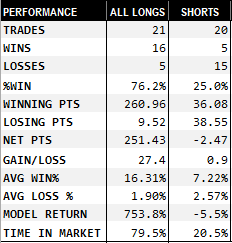
7. STM The standard Seasonality Timing Model (STM) that has been around for many years now and continues to appear in the STM tab in MONTHLY CHARTS but with some enhanced charts and detailed performance statistics. A PRO version that offers significantly enhanced performance joins the OPTIMUM models with some enhanced dashboards and daily updated charts to track trade progress. Whilst both these models have long term bull and bear market history guiding its decisions, its best performance is during bull markets and thus we have classified it as a high-frequency (36 trades since 2009) semi-bull market model. Both STM models have had some stunning out-of-sample performance statistics since 2009 for both longs (91% winning rate), cash holding periods and shorts as depicted below:
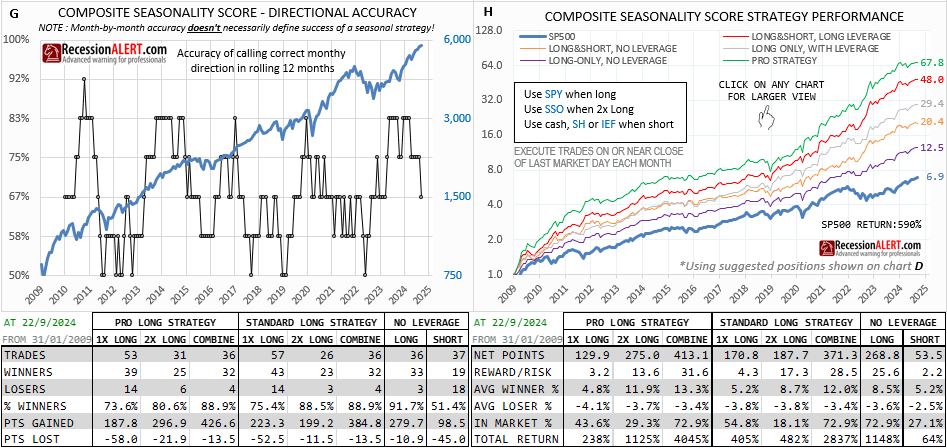
8. OPTIMUM-D1: One of the more novel ways to deploy these models is through a diffusion (hence the D), which counts how many of a selected group of models are long and subtracts how many of them are short. In other words, a NET LONG COUNT. This is possible as each of these models’ designs are predicated on differing performance characteristics. This can be used to scale in and out the market to adjust for risk. The reasoning is that by the time the big bear arrives you will be all-out and so the diffusion can be classified as a macro model. One implementation of the diffusion that deploys all 7 discreet models includes the STM PRO seasonality model and does not duplicate with inclusion of the standard STM model. Additionally, when STM PRO is 2x leveraged in very bullish periods, it has the effect of adding two to the diffusion count instead of 1 used for a standard STM long position. Thus the diffusion (D) can range from -7 to +8 and is displayed below:
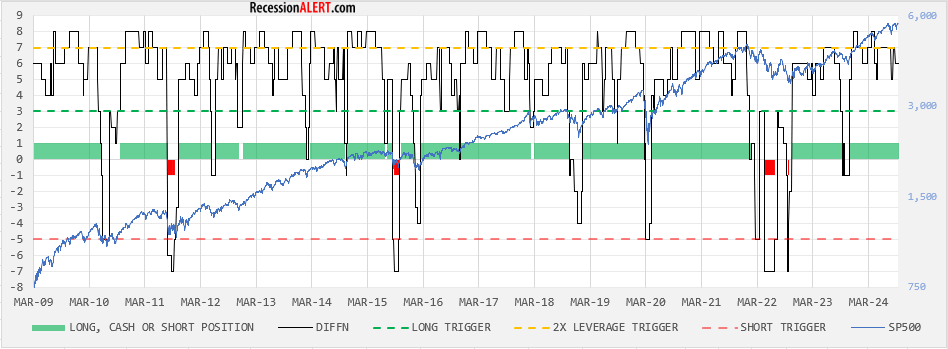
The OPT-D model goes long when DIFFN > 3 (long trigger), goes short when DIFFN <-5 (short trigger), stays in cash when DIFFN between -5 and +3 and goes 2x leverage when DIFFN > 7 (ie when the STM PRO model is leveraged long.) It produced the statistics shown below:
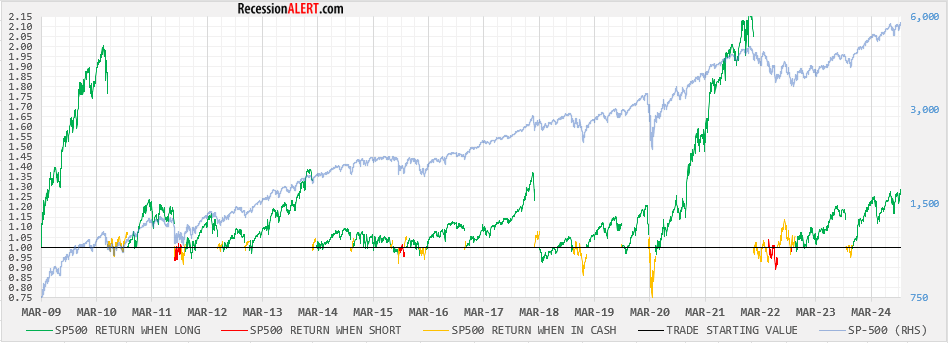
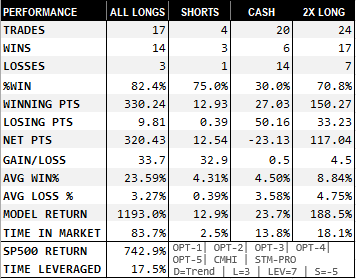
9. OPTIMUM-D2: Another favourite interpretation among users is the same as above but to exclude OPTIMUM-1 from the diffusion and only use 6 models. This can significantly jack up the returns as well as increase the frequency of trades which provides more opportunity for those more active in the market, since the model is less encumbered with the caution with which OPTIMUM-1 deploys to stay out of big bear markets. The DIFFN (D2) count appears below:
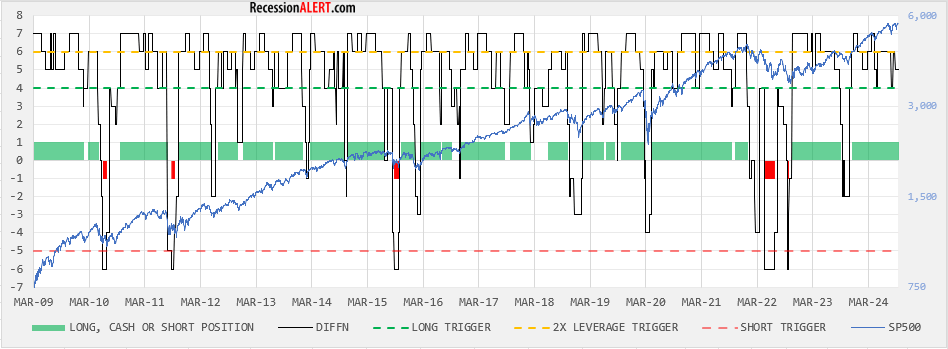
The OPT-D2 model goes long when DIFFN > 4 (long trigger), goes short when DIFFN <-5 (short trigger), stays in cash when DIFFN between -5 and +4 and goes 2x leverage when DIFFN > 6 (ie when the STM PRO model is leveraged long.) It produced the statistics shown below:
10. OPTIMUM ANALYZER :The OPTIMUM Suite of market timing models now have their own historical data file and companion diffusion model-builder that allows you to configure your preferred combination of 8 OPTIMUM models into a single combined diffusion model with configurable “go long”, “go 2X long”, “go cash” and “go short” diffusion thresholds. You can inspect your models’ performance via detailed trade statistics tables and charts depicting SP500, Diffusion, position taken together with returns and drawdowns profiles. Five top-performing pre-selected combinations are also available for you to use (two of which we discussed in the prior paragraph) The file will be updated monthly and is available in the PRO>DOWNLOADS page. A sample of the instructions taken from the sheet appear below:
Again the idea is not to get the best performing model. If you wanted to do that, just stick with the STM PRO seasonality model. But if you wanted to reduce your risk of relying on a single model that may stop working for a while then its best to go for a multi-model approach through the diffusion to minimise MODEL RISK. You land up with a more diversified strategy that provides you with a signal that allows you to scale risk in and out according to market risks whilst still significantly out-performing the buy and hold investor that has perfect hindsight.
11. ALERTING : Any change in the trade status of any of the OPTIMUM models will result in an ALERT being posted in to the PRO ALERTS tab as well as email alerts. In some instances the alerts will be a day in advance if the rules of the algorithm allow it, or if the rules look like they may trigger in the very near future. Many of the OPTIMUM models also feature end-of-day stops that are projected a day in advance so you can intercept a trade action in a timely manner without relying on alerts.


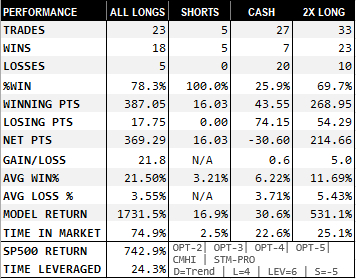
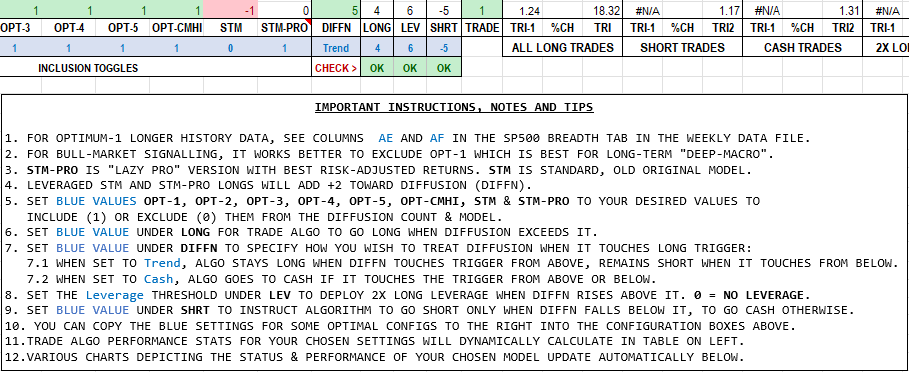
Comments are closed.